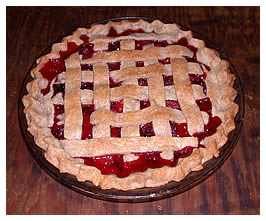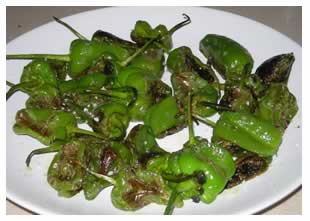Notes from Debbie's Kitchen~~~~~~~~~~~~~~~~~~~~~~~~~~~~~~~~~~~~~~~~~~~~~~~~
This week I think I'll just pull some recipes from my clippings file. You think there are a lot of recipes in the database? (there are)... you should see my clippings file ;-)
- Debbie
. . . . . . . . . . . . . . .
I'd like to start with a recipe I made last night:
Debbie's double-crust triple-berry pieinspired by an old San Jose Mercury News clipping

makes one 10-inch pie
6 cups mixed berries (raspberries, blackberries, cut up strawberries; if you have blueberries you can include them too!)
2/3 C sugar
1 1/2 tbsp. granulated tapioca (use 2 tbsp. if you like your pie 'set'; use 1 tbps. if you like it to be runny)
grated zest of 1 orange
pinch of salt
1 to 2 tbsp butter, cut into pieces
your favorite double-crust recipe [I'll give you mine, below]
Put all the fruit in a large bowl. Combine sugar, tapioca granules, salt, and orange zest in a separate cup then pour over fruit and stir to mix. Let fruit mixture sit while you make your pie crust. Preheat oven to 375 degrees.
Roll out half of pastry and fit into a 10-inch glass pie plate. Transfer fruit mixture to crust and dot with butter pieces. Put on top crust - either lattice it, or cut several slits for vent holes - seal top and bottom crust together and crimp edges.
Protect edge of pie crust with foil and bake for 50 to 60 minutes, until crust is golden and filling is bubbly. Cool completely before slicing.
Debbie's Stir-n-roll CrustOkay, this one's not from a clipping. The original recipe was out of the old Joy of Cooking, but I have modified it to suit my needs over the years. I like it because a) it is easy, and doesn't require any fussing with a pastry knife and ice water... and b) since it is easy, I make pies more often!makes enough dough for two single-crust 10" pies or one double-crust
3 C flour (can make 1 C of this whole wheat flour)
1 1/2 tsp. salt
1/2 C plus 2 tbsp. buttermilk, yogurt, or kefir
3/4 C plus 2 tbsp. canola oil (a little less oil if you use the whole wheat)
[you don't have to use measuring spoons -- 2 tbsp = 1/8th cup, so using a 2-cup glass measure, start with the buttermilk and fill it to the 1/2 C mark and then halfway to 3/4 C, then add the oil in on top until the combined total equals 1 1/2 C]
In a medium bowl, whisk flour and salt together with a fork. Take same fork and whisk oil and buttermilk mixture together to blend (I like to use a fork because the tines act like a mini-whisk), then pour into flour and mix quickly until it all comes together into a ball; shape briefly with your hands if you like.
Break or cut dough into two equal halves. Roll out each half between two sheets of waxed paper (I flatten and shape the dough into a disk about an inch thick first; makes it easier to roll). Lift off one sheet of waxed paper and invert dough over pie plate; lift off other sheet of waxed paper and carefully settle dough down into plate.
Roll out second half of dough the same way. For a simple top crust, just cut slits in the dough before inverting over filling (I like to make my slits radially, like on a sand dollar). For a lattice crust, cut dough into 1/2 to 3/4-inch strips and lay over pie in a criss-cross pattern starting from the middle and working outwards.
After applying either method of top crust, fold or tuck any extra dough overhanging the edges under bottom crust dough and crimp decoratively (I just pinch the dough between my thumb and two forefingers).
Okay, one more non-clipping recipe... and then I'll get to the clippings!Padron Pepper TapasThe Padron peppers you have in your shares this week are really delicious as a snack, appetizer or 'tapas' when prepared this way. Mind you, you must like a fair amount of heat, but if you do, Padrons have an exceptional flavor to them.Ingredients: padron peppers, good quality olive oil, good sea salt
For this, a cast-iron skillet or
comal is necessary... something you can heat really hot without warping.

Wipe padrons clean of any dirt or clinging moisture (if they have been refrigerated, bring them to room temperature first). Leave peppers whole with stems intact; do not remove stems; you use them later as a 'handle' to hold and eat them.
Heat cast-iron skillet or comal -- do NOT put any oil in the skillet; you are going to dry-pan roast the peppers. The oil is for flavoring afterward! Put peppers into hot pan and, using tongs, turn and cook until blistered and blackened in places and they have started to soften. You'll want to turn on any stove ventilation if you have it; this can get a little smoky!
Once peppers are roasted to your liking, remove to a plate or bowl, drizzle and toss with a good, flavorful olive oil and sprinkle with salt. Serve warm.
This is a recipe I've wanted to try for a long time! Maybe by putting it into the newsletter, I'll finally be inspired to do so.Savory Bread Puddingmodified from the original Bon Appetit recipe called "Southern Vegetable Pie"
serves 8
1/4 C good olive oil
3 medium summer squash, cut into 1/4-inch slices
1 large red onion, thinly sliced
8 oz. mushrooms, sliced
Equivalent of 3 bell peppers [ours are all shapes and sizes], different colors if you have them, seeded and thinly sliced
3 garlic cloves, minced
1 tbsp. chopped fresh thyme
6 large eggs
1/2 C whipping cream [avoid 'ultra-pasteurized'!]
1 3/4 tsp. salt
1 3/4 tsp. ground black pepper
4 C half-inch cubes day-old crustless French bread
2 C (packed) grated Swiss cheese (about 8 oz)
1 8 oz. packaged chilled cream cheese, diced
Preheat oven to 350. Butter 13x9x2 inch glass baking dish. Heat olive
oil in heavy large pot over medium-high heat. Add zucchini, red
onion, mushrooms, bell peppers, garlic and thyme, and saute until
vegetables are just crisp tender; about 15 minutes. Cool briefly.
Whisk eggs, whipping cream, salt and pepper in large bowl to blend.
Stir in bread cubes, Swiss cheese and cream cheese, then vegetables.
Pour into prepared dish. Bake pie until egg mixture is beginning to
brown on top and bubbling at edges; about 45 minutes. Let stand 10
minutes. Cut into squares and serve warm.
Tomato Salad with Cucumbers, Arugula and Sardinesfrom an undated Bon Appetit clipping
serves 4 to 6
"Serve with crusty bread to sop up the juices."
1 cucumber, quartered lengthwise, thinly sliced crosswise
1 1/4 lbs tomatoes, seeded and diced
1/2 medium onion, cut into thin rings
1/2 C chopped fresh Italian parsley
1/2 C coarsely chopped arugula
2 tbsp. chopped fresh mint
8 oil-packed sardines, drained, diced
1/2 C extra-virgin olive oil
2 tbsp. fresh lemon juice
2 tsp. grated lemon peel
Combine cucumber, tomatoes, onion, parsley, arugula, mint, and all but 2 pieces of sardines in a large bowl; toss to combine.
Place reserved sardines in medium bowl; mash with a fork until smooth. Whisk in oil and lemon juice. Season dressing with salt and pepper; mix into salad. Transfer to a serving bowl; sprinkle with lemon peel.
Why save the goop?Here's a thought: if you seed your tomatoes in any quantity, save all the juicy 'goop' and strain to get 'tomato water' for other recipes! How? Here's from Bon Appetit:
"Take a good quantity of your favorite summer vegetable, puree it in a food processor, bundle the puree in cheesecloth [if you're seeding a bunch of tomatoes, though, why throw that part out?], and tie it to a wooden spoon. Suspend the bundle over a large bowl or pot and let drain (this can take overnight). The resulting liquid can be seasoned and used as a light sauce, as a surprise in a summery cocktail, or as the base for a clear soup."
So, assuming you probably won't get that much 'goop' from your tomatoes at any one time, why not accumulate and freeze it, then when you get enough, thaw and strain as described above?
Grandma's German Potato Saladfrom an un-dated San Jose Mercury News clipping
3 lbs. potatoes
1 small onion, diced
1/2 lb. bacon, diced
2 1/4 C white vinegar
1 1/8 C sugar
2/3 C flour
1 1/2 tsp. salt
Dash pepper
Peel potatoes, cut into pieces and place in a large pot. Cover with cold water and bring to a boil. Boil until potatoes are tender, about 15 minutes. Drain well, Cut into smaller, bite-sized pieces as desired. Place in large bowl with diced onion.
Fry diced bacon until crispy and brown. Remove bacon from pan using slotted spoon; add to potatoes and onions in bowl. Set pan with drippings aside; you'll use it for the roux.
Heat vinegar, sugar and 3 1/2 C water together in small saucepan until sugar dissolves and mixture comes to a simmer.
Meanwhile, return pan with bacon drippings to heat and add flour. Whisk this rough until well-combined, about two minutes. Add hot vinegar-sugar mixture and stir until it thickens, a minute or two. Add salt and pepper.
Pour sauce over potatoes -- you may not need all of it -- and toss well. Extra sauce can be stored in the freezer [and used for future batches of potato salad! I thought it sounded like an awful lot of sauce.]